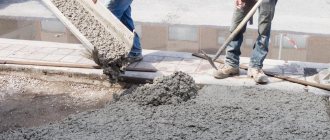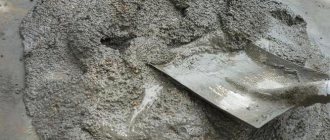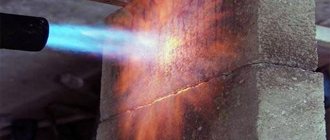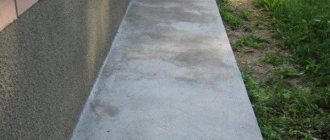Concrete is the bread of construction. Without it, no construction project can be completed; various structures and products are produced, from construction ones - foundations, walls, stairs - to decorative ones - benches, garden paths and small architectural forms. And all this is a simple mixture. True, the proportions of concrete and its characteristics can be very different - to perform different tasks.
Concrete is used to make large multi-storey buildings, paths and small sculptures. For this purpose, concrete of different compositions is used.
Concrete composition: components, their sizes and characteristics
Most concrete consists of three main components:
- The binder is most often cement, sometimes lime.
- Fillers - sand, crushed stone, pebbles.
- Water.
Different quantities of just three components give a wide range of qualities and characteristics. To impart special properties, various additives and additives are also used, which greatly expands the scope of use of this material.
All these brands of concrete are made from the same components, but in different proportions
The main characteristic of concrete is its strength or the load that it can withstand for a long time without losing its strength characteristics. This parameter is the key when choosing the grade of concrete for the foundation. Water permeability and frost resistance may also be important. But these are the characteristics of the “ripened” material, which depend on the recipe. And when kneading, you may be interested in such a characteristic as workability. It reflects the degree of concrete fluidity and depends on the amount of water in the composition. You can increase fluidity without adding water using additives, as well as increase frost resistance and water-repellent properties.
The strength of concrete depends on how accurately the recipe was followed, on the quality of the ingredients and on how thoroughly everything was mixed. Only with a homogeneous composition and high-quality components can design characteristics be achieved. Read more about what components can be used and the requirements for them at the end of the article.
Necessary materials
Before mixing concrete yourself, you need to have the following proportions:
- Water (0.5 parts).
- Sand (3 parts).
- Any filler (for example, crushed stone) – 5 parts.
- Cement (1 part).
Full information about cement can be read in this article.
Sand should be prepared without foreign impurities. It must be clean. The sand size can be used in the range of 1.5 - 2.5 mm.
The filler should be selected without additional components. It is best to use granite crushed stone, the fraction size of which is from 5 to 20 mm - it has good strength and a strong structure when hardened.
It is better to rinse crushed stone before use to remove screenings and dust. This will provide better adhesion to the remaining components for the solution.
Regular drinking water is suitable (1 part cement, 5 parts crushed stone and 3 parts sand will require 0.5 part liquid). But it should not contain impurities. Please note that sea water is not suitable for these purposes.
You can also add plasticizers, which give the concrete unique properties (flowability or viscosity). You can also use various antifreeze additives or hardeners.
Principle of concrete marking
The main characteristics of concrete are its strength and compressive class. The compression class is indicated by the letter “B”, followed by class numbers from 3 to 40, the strength grade is indicated by the letter “M”, followed by numbers from 50 to 1000. They indicate the maximum load that this type of concrete can withstand. For example, the M300 brand means that the maximum load per 1 square centimeter cannot be higher than 300 kg.
In private construction, the most popular grades are M200-M250; for the foundations of two-story houses, M300-M350 concrete can be used; M400 is much less often poured - for heavy buildings on difficult soils. Higher ones are generally rare. Their area of application is industrial construction and objects with special properties (piers, dams, roads, etc.).
The correspondence between concrete grades in terms of strength and compression is given in the table (used in private construction).
| Concrete class by compressive strength | Compressive strength of concrete kg/cm2 | The closest concrete grade in terms of strength |
| AT 5 | 65.5 | M 75 |
| B 7.5 | 98.2 | M 100 |
| B 10 | 131.0 | M 150 |
| B 12.5 | 163.7 | M 150 |
| B 15 | 196.5 | M 200 |
| B 20 | 261.9 | M 250 |
| B 22.5 | 294.4 | M 300 |
| B 25 | 327.4 | M 350 |
| B 30 | 392.9 | M 400 |
| B 35 | 458.4 | M 450 |
| B 40 | 523.5 | M 500 |
How to properly prepare concrete in a concrete mixer
To mix concrete properly, you will need a concrete mixer. In the video you can clearly see the process of preparing the solution in a concrete mixer. If you don’t have it, you can knead it by hand, but this option is suitable for making small portions.
To properly mix concrete in a concrete mixer, you must:
- Prepare pre-calculated portions of water, cement, sand and crushed stone.
- Turn on the concrete mixer.
- Pour water into the concrete mixer.
- Add cement.
- Then add sand and stir for about 2 minutes.
- If the mixture turns out to be very thick, you can add a little water.
- Add crushed stone in small portions (density, fractions, specific gravity of crushed stone can be found here)
- Add plasticizers.
Concrete should be prepared in small portions, and the concrete mixer should be placed close to the pouring site. Due to this, the solution will not set prematurely and harden.
The total mixing time should not exceed 10 minutes so that the solution does not set. But this method is not always used. Indeed, most often, to obtain a certain fluidity of the material, it is necessary to add different amounts of water.
The second method would be the following sequence: add all the bulk materials to the device, then gradually pour in water until the desired consistency of the solution is obtained.
Proportions of concrete of different grades
This entire range and range of qualities is obtained by using the same materials, just in different quantities. To achieve the required characteristics, the recommended proportions must be strictly observed.
When building your house, you want to do everything as best as possible, and therefore, when making concrete, you want to add more cement to make it stronger. This should not be done. It's unlikely to get better, but it could easily get worse. To gain strength, concrete needs a certain amount of water and other components. If there is little water, there is a lot of cement, bonds between particles are formed in insufficient quantities, which is why the concrete can crack and crumble. The same applies to the number of fillers. Both their too high and insufficient content negatively affects the qualities of concrete stone.
Concrete proportions are usually displayed in fractions. The amount of cement is taken as a unit, and the remaining components are prescribed in relation to it. The data is presented in the form of tables for the corresponding brands; the units of measurement must be indicated. You can see such a table of concrete components below.
Proportions of concrete of different grades from Portland cement M400 and M500
How to determine the required proportions of concrete using this table? In the second column, find the required grade of concrete. For example, you need an M250. Depending on which Portland cement you will use M 400 or M 500, choose one of two lines. The third column shows the proportions for concrete in kilograms: for 400 cement it is 1/2.1/3.9. This means this: to obtain concrete grade M 250, for 1 kg of Portland cement M400 you need to add 2.1 kg of sand and 3.9 kg of crushed stone. Similarly, determine the proportions for concrete M200 - the data for it in the table is slightly higher, or concrete M 300 - slightly lower.
The fourth column presents volume fractions: all components are given per 10 liters. They are selected in the same way.
Such tables do not indicate the amount of water. It depends on how thick the solution is needed. The water-cement ratio is given in separate tables. For example, below are data on the number of inputs in relation to a kilogram of cement, provided that medium-sized aggregates are used.
The amount of water to obtain concrete of the required grade when using medium-sized crushed stone and sand
For example, to obtain concrete grade M 300, the proportions of cement M 500 and water are defined as 0.61. This means that for 1 kg of cement, 0.61 liters of water (610 ml) are added to the solution. This produces a medium-plastic solution, which is used most often. But when pouring foundations or other structures with dense reinforcement, a plastic solution may be needed. Then, when determining the amount of water, in addition to the brand of cement, it is also necessary to take into account the size of the aggregates and how fluid the solution should be. These data are presented in the table below.
The amount of water in concrete depending on the size of crushed stone/gravel and the fluidity of the solution
Sometimes it is necessary to determine how much cement you will need for a particular task. To do this, you need to know how much cement is contained in a cubic meter of concrete. Data on concrete and cement grades can be found in the table below.
Amount of cement per cube of concrete
Do-it-yourself concrete - main components
When choosing the composition of concrete for the foundation, proportions and ratios, it is necessary to prepare the following components:
- Cement mixture.
- Sand.
- Crushed stone.
- Water.
Cement
For novice developers who understand how to prepare concrete at home, it is important to correctly calculate the amount of binder - cement.
There are different types of cement mixtures available in the market including Portland cement, slag Portland cement, rapid setting compounds and others. Each option has its own properties, speed of strength gain and scope of application.
Traditional concrete composition and proportions include Portland cement due to its improved performance and availability. Available materials are divided into grades with the letter M and a numerical value that determines resistance to loads.
To make concrete with your own hands, it is customary to use the M400 brand - it has sufficient strength and reliability. Industrial production in Moscow uses Portland cement M500, and for the construction of foundations in difficult conditions, special compounds of a higher grade are used.
To prepare a concrete mixture, you need to know exact information about the brand and quality of the component used. It is also important to take into account such a property as freshness - the shelf life of a concrete product depends on it.
The fresh mixture is a crumbly dust with no compactions or lumps. If there are large elements in cement, it is better not to use it for construction work.
Sand
The concrete recipe for the foundation requires the presence of sand. There are different types of such a component, which differ in their composition and properties, and also determine the quality of the final product.
When figuring out how to make a concrete solution, you can choose any type of sand. The main thing is that they do not contain large amounts of dust, clay and large particles that worsen the properties of the mixture.
Experts recommend choosing sea or river sand, since these types do not contain dust, clay and organic compounds. As for raw materials mined in quarries, they can be quite dirty and require preliminary preparation with washing and settling.
This sand may also contain organic debris, including tree roots, leaves, bark and branches. If such particles end up in the concrete mixer, the concrete will be of poor quality and its strength will deteriorate.
An indicator such as sand moisture should be assessed. Even in dry material, up to 2% water can be present, and in wet material - up to 10%. In this case, the ratio of concrete for the foundation will be violated.
Crushed stone, gravel
When studying what a concrete mixture consists of, you need to pay attention to crushed stone and gravel. These rocks act as fillers and are responsible for the strength of concrete products. In most cases, crushed stone is used, which has different fractions and surfaces.
When preparing the composition, you cannot replace the filler with sea or river pebbles, since these components have a smooth polished surface and do not provide good adhesion to other components.
The proportions of the concrete solution affect the service life and reliability of the product. The permissible size of stones in crushed stones should not be more than 1/3 of the minimum thickness of the structure being built. The hollowness of the crushed stones or the amount of space between the stones is also taken into account.
To calculate this parameter, you need to take a bucket, place the filler there and gradually add liquid. The volume of water placed will indicate the void ratio. Therefore, experts calculate the proportions of concrete for the foundation in buckets.
To improve the process of filling voids with concrete mixture, it is recommended to combine different fractions of crushed stone. In addition to gravel and granite crushed stone, the following fillers can be added to the composition:
- Expanded clay.
- Blast furnace slag.
When creating lightweight concrete, wood shavings or expanded polystyrene granules are used.
Water
When starting to mix concrete, you need to take care of water. It is recommended to take drinking liquid that is used for household needs. It is prohibited to use water from questionable sources, waste water or swamp water. Depending on the ratio of components in concrete, its operational properties are determined.
When performing calculations, it is necessary to take into account the content of all moisture that is in the feedstock before mixing. If the composition includes blast furnace slag, it is important to determine what moisture content such material has, since “excess” water can worsen the characteristics of concrete.
The volume of liquid affects the mobility of the material. To create plastic concrete, it is necessary to adhere to proportions and not deviate from the given norm. Otherwise, the mixture will begin to separate and deform.
The degree of plasticity can be determined visually after the concrete has hardened. If it randomly slides off the bayonet shovel, this indicates good ductility. When sliding slowly, the mixture is said to be of little plasticity, and the solution held on the shovel by a tubercle is classified as non-plastic.
Supplements
To mix the solution and improve its quality properties, good proportions for concrete components include the presence of additives. They are intended to increase frost resistance and resistance to corrosion processes, reduce hardening time, change strength properties and other purposes.
Existing components are selected according to the following classification:
- Plasticizers - used to increase the strength and density of concrete.
- Air-entraining additives are used to obtain a porous structure, which increases the resistance to negative temperatures of reinforced concrete structures.
- Impurities to accelerate hardening - allow you to reduce the hardening time of the mixture. There are impurities with the opposite principle of action that slow down the setting process.
- Compaction additives - help increase durability and fill cavities between concrete grains.
- Corrosion inhibitors - can create an oxide film on the anode.
- Gas-forming elements - used in the production of gas blocks. Capable of increasing water resistance and reducing the intensity of delamination.
- Anti-frost - intended for construction work at temperatures down to -20°C.
When selecting suitable admixtures, it is necessary to consider the type of task they perform. Modern components are capable of:
- Improve the performance characteristics of concrete.
- Increase strength and resistance to moisture, corrosion or frost.
- Reduce the hardening period.
- Reduce component consumption.
- Influence mobility indicators.
Areas of use
We have decided what materials are required for concrete in what proportions, but what brand is needed? This depends on the purpose of the structure and its operating conditions. It will be easier to navigate if you know which grades of concrete can be used for what (let’s name only those that are used in the construction of a private house, its renovation or landscaping).
M100 (B7.5). This is the so-called lean concrete. It is used to prepare sites for critical structures. For example, when building a strip foundation, a layer of lean concrete is laid on a gravel-sand backfill, and then reinforcement work begins. The same composition is used when laying curb stones, for example, when making paths or blind areas around the house.
M150 (B12.5). This composition is used in preparation for slab foundations, for screeds, pouring concrete floors or garden paths. This type of concrete can be used to make foundations for small lightweight buildings such as a wooden bathhouse or a small guest house made of timber or logs.
M200 (B15). One of the most popular brands of concrete. It is used to make foundations of any type for light houses on normal soils, screeds, stairs, blind areas, paths. Cement blocks are made from this brand of concrete at home, and it is also used in factories for the production of foundation and building blocks.
Read about how to build your own foundation from FBS blocks here.
The ratio of cement and sand for concrete affects the strength characteristics
M250 (B20). The scope of application is almost the same, but in more difficult conditions. They make any foundations on difficult soils, or on normal ones, but for houses built from heavy materials. They make blind areas that will be used as paths, external stairs, concrete porches, fences, etc. It is also used to make floor slabs for light loads.
M300 (B22.5). Also suitable for all areas listed above, but under even more severe operating conditions. They make foundations for heavy houses on heaving soils, make monolithic walls, paths, waterproof blind areas, etc. This brand of concrete is mainly used to make floor slabs and grillages for pile-grillage foundations.
M350 (B25). The strength of this brand for private construction is generally excessive. This concrete is used for the construction of monolithic pool bowls or for the manufacture of foundations at high groundwater levels, for other structures that require high water resistance. This brand is already more often used in industrial construction.
M400 (B30). This is already an expensive brand of concrete, which is used in facilities with special requirements: for large swimming pools, dams, bank storage facilities, etc.
Proportions for outdoor screed
The ratio of concrete for outdoor screed and its structure differs from the ratio and structure of the components for interior work. When the screed is in the open air, it experiences significant temperature changes, in addition to the negative effects of precipitation and wind.
For this reason, you should use M150 and be sure to iron the top layer. Ratio of concrete screed used outdoors:
- 1 share of M400 cement, 4 shares of the purest river sand, 5.5 shares of crushed granite, 0.9 shares of water.
- 1 share of M500 cement, 4.1 shares of the purest river sand, 5.5 shares of granite crushed stone, 0.7 shares of water.











